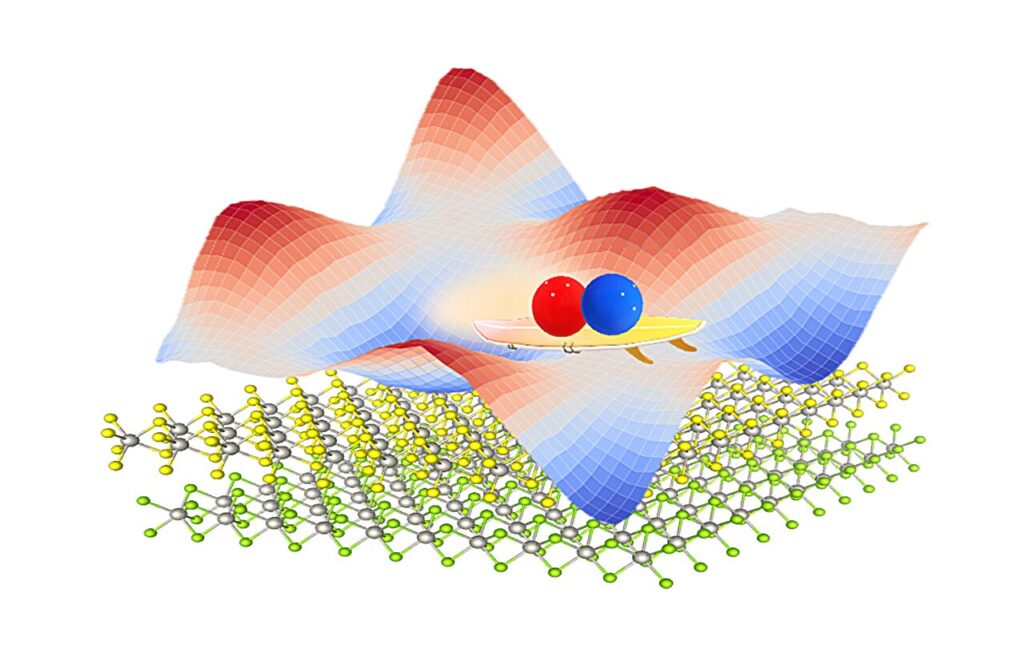A moiré pattern appears when you stack and rotate two copies of an image with regularly repeating shapes, turning simple patterns of squares or triangles into a groovy wave pattern that moves across the combined image in an optical delight.
Similarly, stacking single layers of sub-nanometer-thick semiconductor materials known as transition metal dichalcogenides (TMDs) can generate a moiré potential, and novel electronic and optoelectronic properties may emerge between the layers.
A moiré potential is a “seascape” of potential energy with regularly repeating peaks and valleys. They were previously thought to be stationary. But a team of researchers at the Molecular Foundry at Lawrence Berkeley National Laboratory (Berkeley Lab) has uncovered something unusual about the moiré potentials that emerge when TMDs are stacked: they are constantly moving, even at low temperatures.
Their discovery contributes to foundational knowledge in materials science. It also holds promise for advancing the stability of quantum technologies, as controlling moiré potentials could help mitigate decoherence in qubits and sensors. Decoherence occurs when interference causes the quantum state and its information to be lost. The researchers published their findings in ACS Nano.
The research is part of broader efforts at Berkeley Lab to advance quantum information systems by working across the quantum research ecosystem, from theory to application, to fabricate and test quantum-based devices and develop software and algorithms.
Research was led by Antonio Rossi, a former postdoctoral scholar under Molecular Foundry staff scientist Alex Weber-Bargioni. Rossi came back to Berkeley Lab to collaborate with Molecular Foundry staff scientist Archana Raja and make use of the tools in the Foundry’s Imaging and Manipulation of Nanostructures facility.
Unexpected mobility in the moiré seascape
Raja’s lab focuses on characterizing 2D materials using ultrafast lasers and optical spectroscopy at temperatures below -150°C. Exciting the layered TMD samples with a green pulsed laser energizes electrons and causes them to jump from their ground state to an excited one. Excited electrons leave behind a ‘hole’ with a positive charge, resulting in an electron-hole pair or exciton.
Excitons are known to form within single-layered materials. However, excitons in the stacked two-layer system separate; electrons move into the tungsten disulfide layer, and positively charged holes get left behind in the tungsten diselenide layer. In the materials community, these special layer-jumping excitons are known as “interlayer excitons” or IXs.
“You would expect the moiré valleys to act as traps,” Rossi said. “So once the exciton is in there, it’s basically trapped. It’s like sitting (in a valley), and all you can see is the mountains around you. You’re not moving.”
However, the team noticed that IXs explored the moiré’s seascape despite being trapped within it. “It takes very little energy to make this moiré potential move, so the moiré is moving around exactly like a stormy sea,” explained Rossi.
“We showed that even at very cold temperatures, energy and information are not as localized as you might expect. This happens because of a special ‘mechanical property’ of the moiré pattern,” said Raja. “There are different ways to transport energy and information at different temperatures. This is a new way to do that.”
Collaborator Jonas Zipfel, a postdoctoral researcher in Raja’s group, worked with Rossi to automate their measurements to better understand the excitons’ motion. “Jonas’ work made it so we could seamlessly collect luminescence spectra, image, and lifetime (data), all of which enabled us to extract the diffusivity (movement) of the excitons,” said Raja.
To enable the observation of excitons in motion, Johannes Lischner and Indrajit Maity from Imperial College London used simulations to obtain snapshots of the moiré’s potential “seascape.” They wanted to see how it behaved at different times.
By working with theorists Lischner and Maity, the research team arrived at the only logical explanation for their observations: the moiré potential itself must be moving.
Catching a low-temperature quasiparticle in motion
The researchers have proposed that a low-temperature quasiparticle called a phason enables the IX to move even while it’s trapped. A quasiparticle is a quantum of energy within a crystal lattice; it has momentum and position and generally behaves like a particle. Phasons are quasiparticles thought to be naturally present in the moiré potential.

“You have the (interlayer) exciton surfing the moiré and moving around,” Rossi stated. He believes the phason mediates the movement in the same way a surfboard allows a surfer to catch waves. “It’s kind of carrying the exciton, in a way.”
Rossi and team found the motion of the interlayer excitons within the moiré potential to be angle and temperature-dependent. Their movement is at a maximum when TMD layers are parallel (when the molecules of the stacked layers align in the same direction).
Unexpectedly, as the system temperature approaches zero, the motion of the interlayer excitons tapers gradually to a number that is slightly higher than zero, rather than coming to a complete halt. And while the number is small, it’s significant.
Rossi explained, “It was a surprise to find that this movement happens even at really low temperatures when everything is supposed to be frozen.”
His next steps include investigating the superconductivity in twisted bilayer graphene that may arise from phason quasiparticles. Rossi is currently doing research for the Center of Nanotechnology Innovation at NEST, Institute of Technology, Italy.
Raja is interested in exploring different semiconductor and moiré systems. She’s also intrigued by the possibility of imaging phasons directly. She said, “Our evidence here is through the diffusion of the (interlayer) exciton, but we haven’t necessarily caught the phason red-handed, yet.”


